
A project proposal is how you can get management to act on your ideas. They’re the bottom-up version of a project request form.
Writing a project proposal isn’t rocket science, but it is a lot harder if you don’t have something like a template to give you a head start.
Using a template for your proposals gives you a document which you can reference throughout the entire project. It’s a great example of effective business process management – the proposal acts as a banner that your whole team can rally around to ensure you’re all working towards the same goal.
So, in this Process Street post, I’ll go through how to create a project proposal, that gets approved, by going through the following topics:
- Free project proposal template
- 12 more free project proposal templates
- What makes a good project proposal?
- Key tips for writing effective project proposals
- Writing a lot of project proposals? Check this out!
- More stuff to help you write amazing project proposals
Free project proposal template
If you’re in a hurry and you need a simple, effective project proposal template you can pick up and use immediately, then check out our Project Proposal Template Checklist.
You can also find the same project proposal template embedded just below.
Template: How to write a project proposal
Click here to get this project proposal template!
If you’re in need of a more specific template, we also have a bunch of other project proposal templates below, for pretty much any kind of project proposal use case you could think of. Just click the header to expand it and see the full workflow template.
12 more free project proposal templates
⬇️ Click here to see our template for a formally solicited project proposal
A formally solicited project proposal is made in response to an official request for a proposal. In a way, this is the easiest way to create a proposal for a new project, since the Request For Proposal (RFP) document will usually tell you exactly what the customer or audience wants and sometimes even directions for preparing the proposal.
RFP forms aren’t to be confused with project request forms though – the former is a way to directly react to specific needs and desires, whereas the latter is a way for higher management to request a project of their teams.
Therefore, for formally solicited proposals you should take a more structured approach. You have to respond directly to the contents of whatever rough details have been relayed to you, essentially turning feedback into a quantifiable project which you can then judge the worth of starting.
Your project proposal checklist doesn’t need to be complicated. The template below is an example of how a simple checklist can help you to write your project proposals.
Remember that this simple template can be used for formally solicited, informally solicited, and unsolicited project proposals alike.
⬇️ Click here to see our template for an informally solicited project proposal
Informally solicited project proposals are the same as formally solicited ones, except the information they are based on isn’t set out in a specific document. This makes them a little harder to deal with (more research is involved in analyzing them), but you at least have a rough starting point.
It’s pretty much just a lack of detail that separates formal from informal – formal proposal requests have set details, goals, deliverables, and potentially even methods, while informal ones could be based on a conversation. If you’ve been asked for a proposal but haven’t been given any specifics, it’s an informally solicited one.
Again, the approach for this isn’t too different from a formally solicited one, but you’ll have to put in some extra legwork in defining details like the objectives and method and in assessing how viable the whole thing is.
To get a template you can use to create an informally solicited project proposal, check the previous section.
⬇️ Click here to see our template for an unsolicited project proposal
Unsolicited project proposals are the project equivalent of cold calls – nobody asked to receive one, but (if you’ve done your homework), it can still provide a ton of value. These are proposals that are thought of by the person submitting them and can be inspired by anything, from a eureka moment in the employee’s daily work to a casual conversation with a customer.
Arguably these are the hardest proposals to write, as you’ll have to be extra persuasive (nobody asked for the proposal, so they’ll need extra nudging). This means gathering more evidence than usual to prove the proposal’s worth and taking extra care when writing to make sure that it’s convincing.
To get a template you can use to create an unsolicited project proposal, check out the previous section on formally solicited proposals.
⬇️ Click here to see our template for proposing to continue a project
Continuation project proposals are by far and away the easiest to write since these are essentially reminders/updates for ongoing (and already approved) projects.
These are almost not even proposals, in the sense that you’re not asking for anything new or pitching your case. Instead, all you have to do is remind the audience of the project they previously approved, report on its progress, account for any changes, and ask for permission to continue.
Usually, continuation proposals are reserved for requesting funds when starting a new phase in a project.
⬇️ Click here to see our template for proposing to renew a project
Once an ongoing project has finished or outlived its usefulness (and support for it is going to be terminated), a renewal project proposal can be written to make the case for its continued support.
Much like continuation proposals, these are less about convincing the audience of the project’s worth by itself and more about showing why it’s valuable to continue doing it. This usually means weighing up the return benefits with the resources it takes to upkeep the practice.
It’s also good to compare the project you’re trying to get renewed support for with other continuing projects – this puts its worth in the context of other ongoing efforts and can indicate areas better suited to being discontinued.
⬇️ Click here to see our template for making a proposal for supplemental project resources
A supplemental project proposal is required when you need to ask for extra resources for a project (beyond those originally proposed). The main aim when writing these proposals is to be able to justify the extra resources and produce updated estimates of what the project will now take to complete.
If the project’s scope is being increased to have a further reach, then this will read as an extension of the original document with a focus on explaining the benefits of expanding the scope.
However, if problems or new information have arisen that means the original goals require extra resources, you should instead focus on reiterating the benefits that the project will bring, explain why such problems and/or information weren’t seen in advance, and reassure the audience that the operation is still worth the investment.
⬇️ Click here to see our template for a business proposal
This business proposal template is basically a sales pitch on paper. Its primary purpose is to persuade a company or organization to do business with you.
It should describe what you can do to solve the problem, how you plan to solve the problem, and the finer details about what, when, why, and how it will solve the problem.
It should also contain a key call to action that will compel the recipient to take the next step.
⬇️ Click here to see our template for a contractor proposal
A contractor proposal is a written outline of the project that’s to be completed by the contractor.
The goal for any contractor proposal is to introduce yourself, highlight your services, describe the costs, and convince the client that you are the right one to trust for the job.
This ‘Contractor Proposal Template’ checklist covers the high-level items that every general contractor proposal should include. Use it alongside the proposal document you plan to submit to make sure you include information such as resources needed, estimated costs, past experience, and payment schedules.
⬇️ Click here to see our template for a consulting proposal
A consulting proposal outlines the working relationship between the consultant and the client so that both parties can stay aligned and understand the other’s expectations.
It’s a document sent from a consultant to a prospective client describing a job they wish to take on and the conditions under which they will do so.
⬇️ Click here to see our template for a grant proposal
The process of how to write a grant is a long one, and it can seem overwhelming at first.
Final decisions about which proposals are funded often come down to whether the proposal convinces the reviewer that the research project is well-planned and feasible and whether the investigators are well-qualified to execute it.
⬇️ Click here to see our template for a sponsorship proposal
A sponsorship proposal needs to convince a potential investor that it’s in their best interest to invest. Use this checklist to make sure your proposal is persuasive, effective, and targeted enough to win the sponsorship money.
⬇️ Click here to see our template for a research proposal
Use this checklist, alongside the proposal document you are planning to submit, to convince others that you have a worthwhile research project and that you have the competence and the work plan to complete it.
If you’re interested in learning how to write the best project proposal possible, read on for some pro tips for writing project proposals that actually get accepted.
What’s the goal of a project proposal?
The goal of a project proposal is to communicate your project’s core value proposition to an interested party. It should establish the scope of the project, including expected outcomes and how you plan to execute it. It also serves as a roadmap that defines each step of the project so that everyone involved is on the same page, working towards the same goals from the start.
One of the most important things about a project proposal, but one that is often forgotten, is that project proposals should serve to convince whoever you’re proposing to that the project is worthwhile. That could be an investor, a C-level executive, or even your teammates (buy-in from your team is always important, after all).
That’s why getting inside the heads of the people you are writing the proposal for is vital; you need to think like the project’s stakeholders to deliver a proposal that meets their needs.
In other words, the goal of a project proposal is to get approved.
What makes a good project proposal?
The best kind of project proposals, the ones that knock it out of the park and convince everyone on the receiving end of the presentation that this is something worth investing time and money in, are the ones that:
- Understand who they’re speaking to (and leverage that knowledge)
- Understand that people have a very short attention span
- Focus on essential information
- Use simple language, and focus on clearly communicating a message (as opposed to needlessly confusing people with jargon)
- Do adequate preparation & research
- Focus on the outcome with a clear, straightforward plan for execution
So how do you pack all this into your project proposals? Let’s dive into the process of writing an effective project proposal.
️ Key tips for writing effective project proposals
There are two stages to the creation of an effective project proposal:
- Planning
- Writing
Let’s start with planning.
Adequate planning: Understanding your audience & core message
Planning a good project proposal looks something like this:
- Define your audience
- Clearly define the scope of the proposal
- Be clear about predicted outcome of the project
- Assess the time and resources the project will need
- Plot a project roadmap
Don’t worry too much about the language you’re using or being terribly well-formatted here. Instead, focus your attention on getting the base facts right and covering yourself for any questions that might counter your proposal.
⬇️ Define your audience (click to expand)
If you’re aiming to get your proposal approved, you need to convince the person reading it that it’s worth the time and resource investment. To do that, you need to know who your audience is, what they prioritize, and what they’re likely to be resistant to.
So, the first thing you need to do when planning your project proposal is to define your audience.
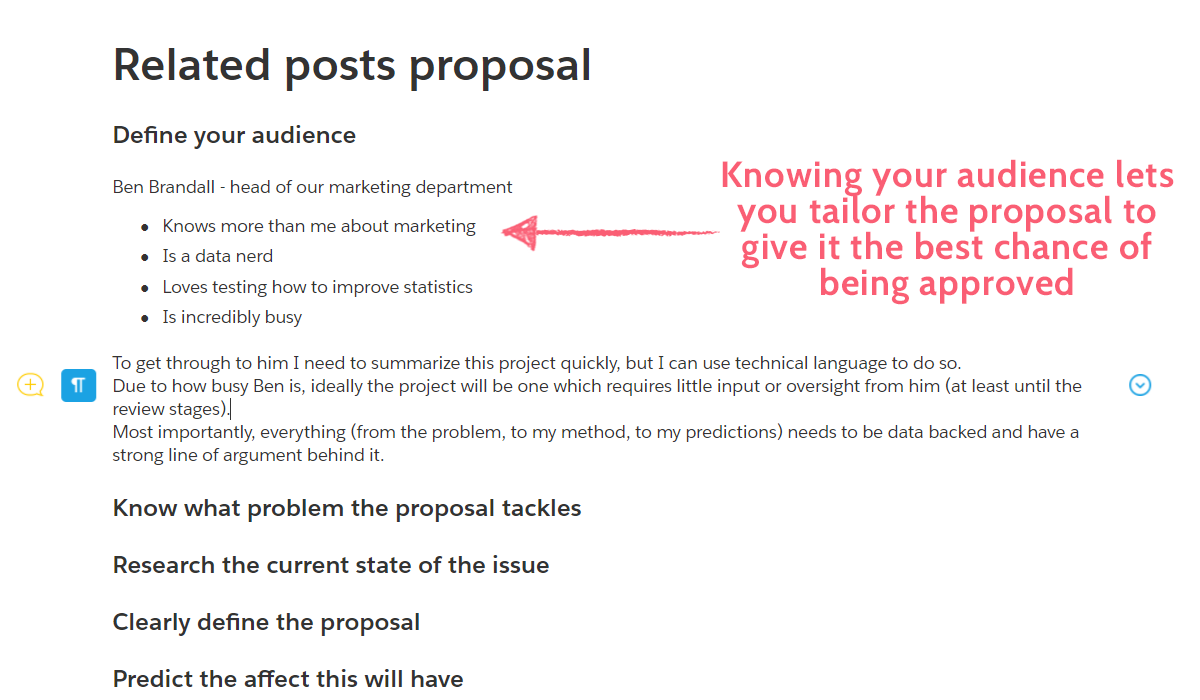
Lay out exactly who they are, what their position is (manager, CEO, potential customer, etc.), and whatever you know about their background. This will then let you relate every aspect of your proposal back to them to make it as appealing as possible.
You’re also assessing how much detail you need to go into with the various concepts of your proposal. If your audience doesn’t know much about what you’re proposing, you’ll want to take extra care to explain it in a language they can understand and therefore see the value in what you’re saying.
For example, if I was pitching a project to our head of marketing (Ben Brandall), I’d take special note of his focus on data (shown by posts like his breakdown of 250 SaaS pricing pages) and use that knowledge to pitch with more evidence to back up my points, as shown above. Since he’s familiar with most things marketing, I’d also be able to use more specific terms and concepts – he has the background knowledge, so there’s no point in patronizing him with surface details.
⬇️ Define the scope of the proposal (click to expand)
Now that you know what your problem is, what’s already been done to solve it, and who you’re writing for, you need to work out and clearly define what your project proposal is. Don’t worry too much about relating it back to your audience just yet – for now, the focus should be on coming up with a solution to the problem.
The key here is to not go overboard with detail. You only need to say what your proposal broadly is and the steps that will be taken to complete it.
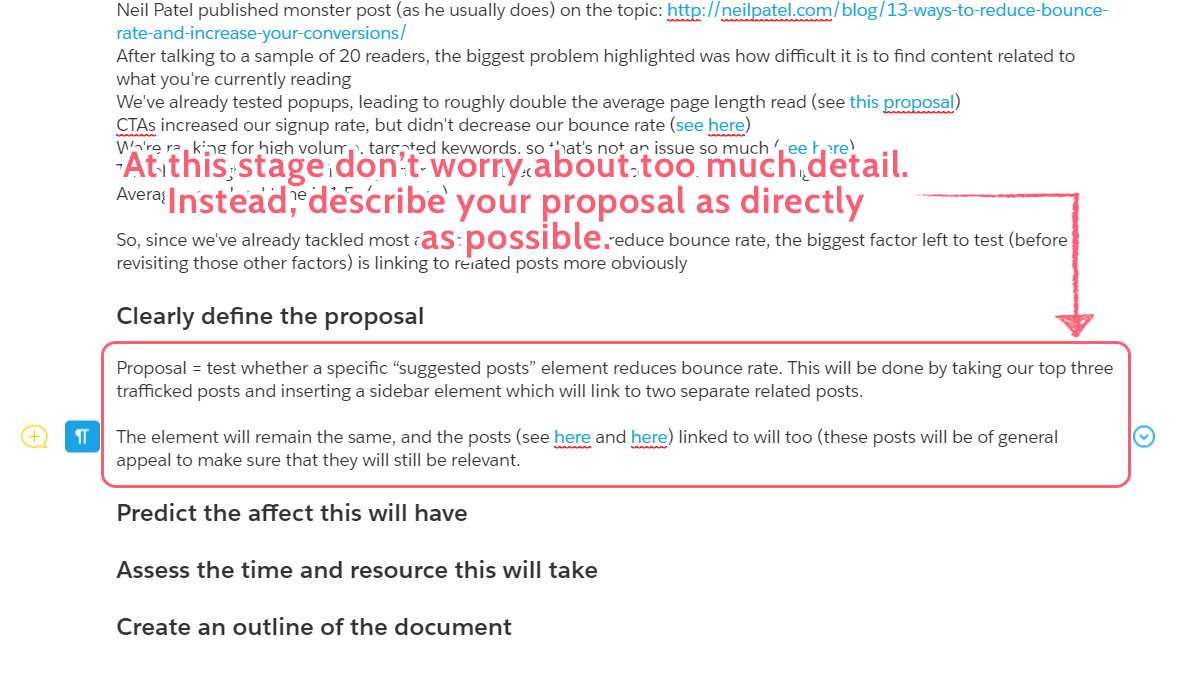
⬇️ Be clear about predicted outcome of the project (click to expand)
Anyone with the power to approve your proposal will likely have one question in their mind after hearing it; “why is this the best solution to the problem?”. If they can’t make the link between your proposal and the problem you’ve highlighted, you’ll never get past the pitch.
So, here in your plan, you need to lay out your predictions for the proposal and how it will benefit your audience. Using what you know of previous experiments, the current state of your main problem, and what your proposal does, lay out the success metrics for your proposal and attempt to predict the results.
Don’t be afraid to highlight the factors which could negatively affect your proposal either. Knowing these and pointing them out will at least let your audience know the risks involved and can allow you to alter your proposal before submission to account for weak points.
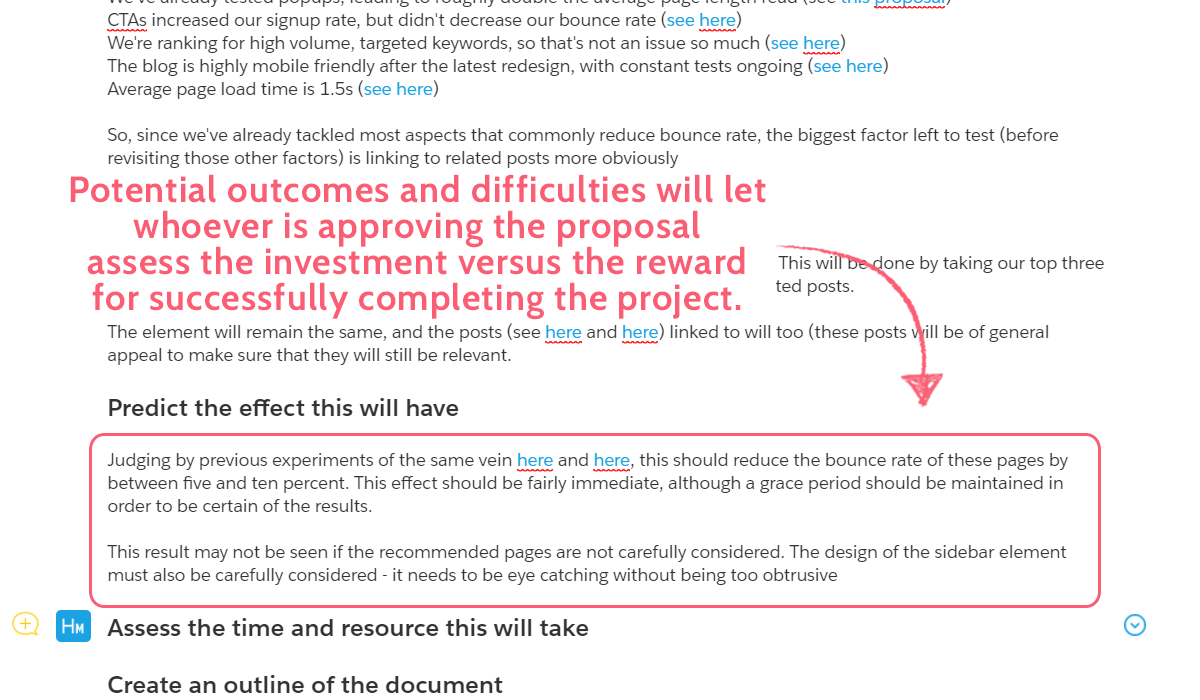
Above all else, this is the stage in your proposal where you’ll be justifying your proposal to the audience, so don’t be afraid to be harsh and alter your proposal to account for any weaknesses you find. You can’t hide them (doing so sets you up for failure in your audience’s eyes), so instead, do what you can to minimize the risks and improve the predicted outcomes.
⬇️ Assess the time and resources the project will need (click to expand)
Progress doesn’t come for free, and now it’s time to look into the time and resources your proposal will take to complete. This will let you know whether the proposal is worth the investment before even submitting it – if you can see that the time and resources far outweigh your predicted outcomes, chances are that it’s worth saving your audience’s time and not pitching it at all.
Being conservative when estimating the time and resources your project will take is a surefire way to fail to meet expectations and deadlines, so you also shouldn’t sugarcoat these elements. It’s better to give yourself room for a little error and be underestimated than to keep everything tight and have to submit a supplemental proposal.
Note down what teams will be working on the project, the specific expertise (and, therefore staff members) the various stages will take, how long their tasks should take them, and any resources beyond the base time commitment.
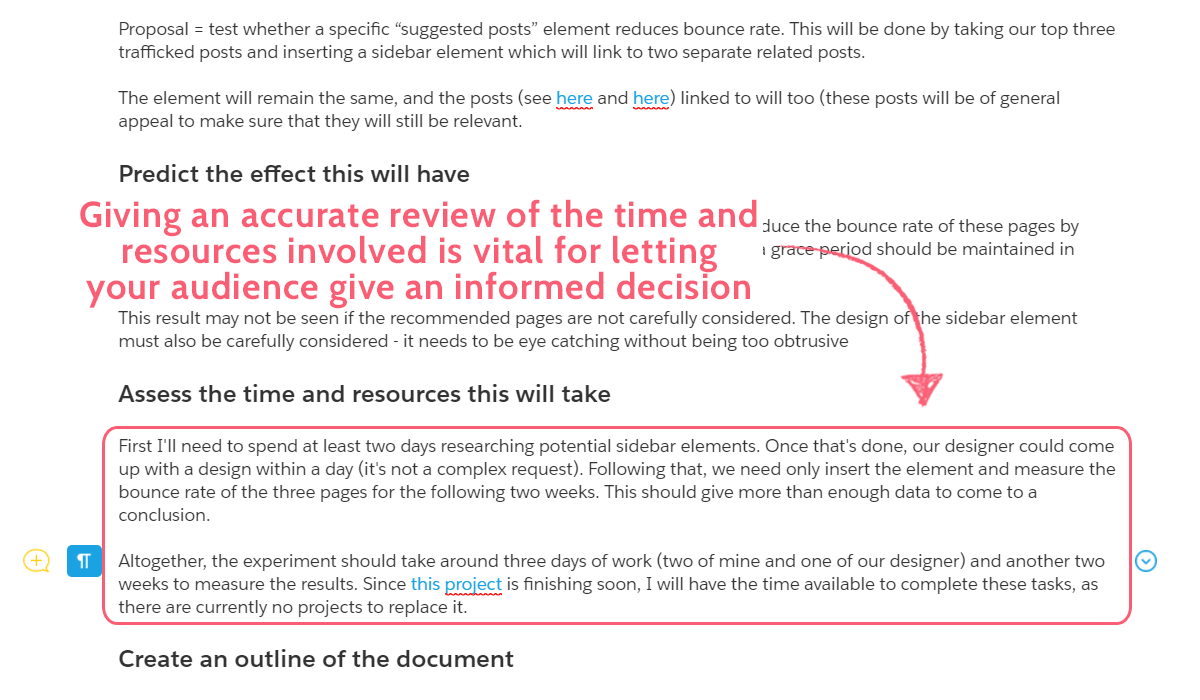
Don’t forget about each staff member’s other commitments too – if possible, you should aim to fit the proposal in with their current schedule rather than take attention away from other tasks. This won’t always be possible, but at least make sure you know what you’re asking for.
⬇️ Plot a project roadmap (click to expand)
Finally, once you have all the information you need, it’s time to plan the outline for your project proposal. Don’t worry about making everything look nice or read perfectly for now – focus on getting the core elements of your proposal on one page. Then, you can worry about the specific language when you’re actually writing your proposal.
Although the exact layout of your proposal will change based on the format you use and how your team usually submits them, in general, make sure you cover:
- An introduction that summarizes the proposal and hooks the audience
- The problem you’re tackling
- The solution you’re proposing
- The method for your solution (step-by-step)
- Why this is the best course of action
- The time and resource commitment (potentially including budget)
- A conclusion that reinforces your proposal
Remember to pose all of the evidence and points you’ve gathered from the perspective of what your audience cares about and in a language they understand. When you’re pitching to a team manager, colleague, or the CEO, they need to be able to see why they should care about the proposal and why it’s the best thing they can do to solve the problem.
Once you’ve got this outline done, it’s time to move on and learn how to write a proposal.
✍️ Clear, concise writing: Keep it simple, stupid!
When it comes to writing a proposal, your structure should look something like this:
- The introduction
- The problem
- The solution
- The justification
- The schedule and/or budget
- How the whole thing will be measured/tracked
- The conclusion
I’ll cover each section & give advice while showing & referring to an example project proposal.
Specifically, I’ll be looking at this proposal for an assessment of a nuclear waste storage site.
✍️⬇️ Hook your audience in the introduction (click to expand)
Having a hook in your introduction is vital for catching the interest of your audience. If they’re not interested in the proposal from the get-go, then it’ll be much harder to convince them of the benefits and therefore get their approval, and that’s if they don’t dismiss the whole document after a cursory glance.
If you come across any striking statistics when looking into the problem you’re tackling, use them in your first line. This will help to catch their interest and lead them into the rest of the proposal, especially if you can relate the figures back to something they know and care about.
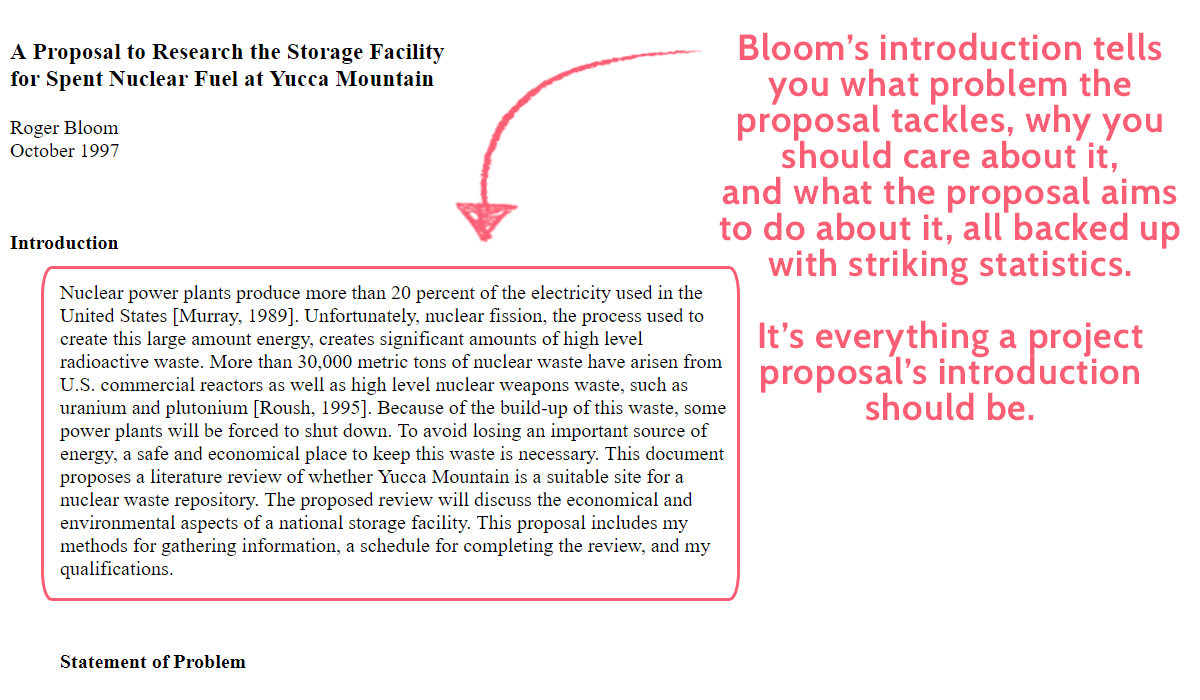
Above all else, don’t make your introduction more than a couple of sentences (three or four at best). Shorter introductions are not only easier to read, but by limiting the space you have to work with, you force yourself to focus on only the most important details.
Hit the audience with a reason to care about the problem, give a little context on what’s currently being done about it, then quickly describe what your proposal will do to tackle it.
✍️⬇️ State the problem (click to expand)
Follow up your introduction with a summary of the problem that your proposal tackles and what the current state of it is. Use the research from your plan to spend a couple of sentences explaining what it is, what’s being done about it both internally and externally, and why your audience should care about it in the first place.
There’s not much else to say here – you need to clearly define the problem you’re tackling using the research you conducted when planning the proposal. The only thing you need to remember here is to relate it back to your audience using language and concepts they understand and value.
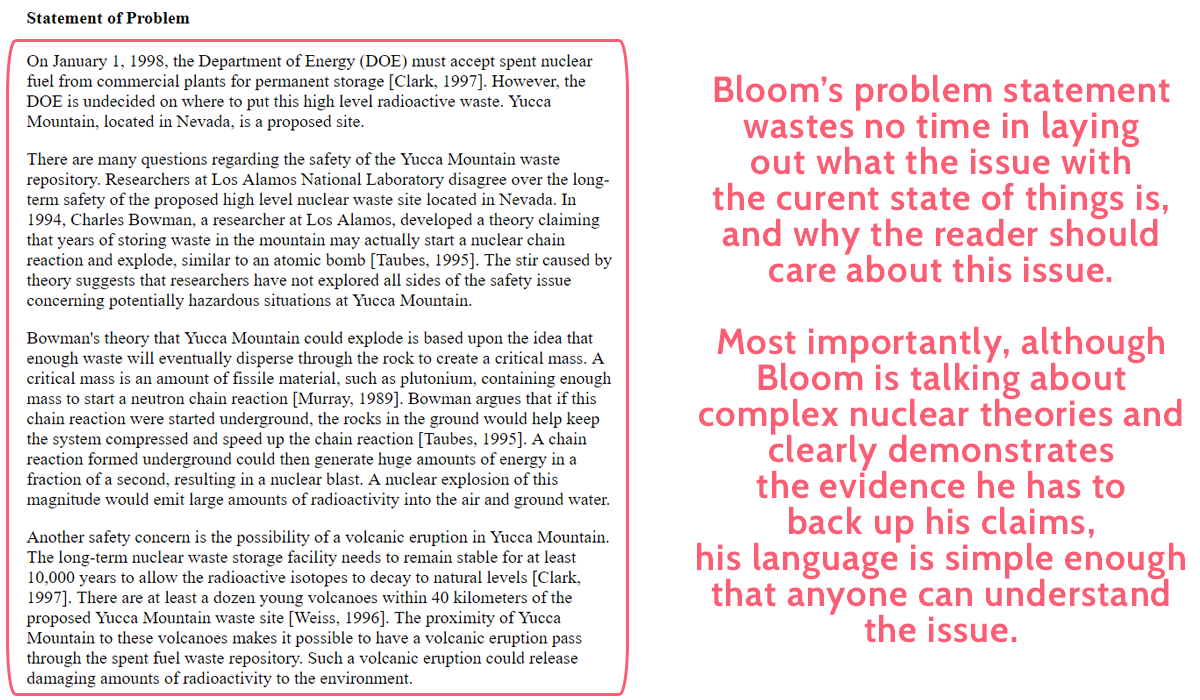
✍️⬇️ Pose your solution (click to expand)
Once they understand the problem they’re facing, it’s time to present your proposed solution. You need to give both a rough summary of the purpose of your solution and the steps it takes to achieve that goal.
Again, don’t get lost in detail here, as that’s a surefire way to make your audience lose interest. Instead, give them the proposed method in a way they will understand and clearly highlight how this will tackle the main problem.
Here you not only need to relate the solution back to your audience, but it’s vital that the method is as specific as possible to show them exactly what steps will be taken and reassure them that you’ve done the appropriate research into what this entails.
✍️⬇️ Justify your suggestion (click to expand)
Although the value of your solution should be clear from how you’ve presented both it and the problem it tackles, it’s worth re-iterating why your method is the best course of action. While this can be done in the previous section of the proposal, dedicating a short segment will let your audience easily scan the document to see the value immediately.
In a couple of sentences (ideally a single paragraph) go over how you predict the proposal will affect the problem it’s tackling, and ideally back up these assertions with evidence from previous and/or similar attempts in the past.
✍️⬇️ Include a project schedule and budget requirements (click to expand)
If all’s gone to plan, then your audience should be on board – now it’s time to give them all of the information they need to know what the project will cost and how long it will take to complete. Break down the proposed solution into specific steps with a rough time estimate for each, and give a budget that accounts for any extra items, staff, technology, and so on.
This will let your audience visualize the timeline and cost of your project as opposed to the benefits that it brings. As such, they need to have enough detail to be able to judge the worth of the proposal, such as the time investment of various team members and departments alongside any funds for items beyond your current inventory.
It might seem like overkill to lay out the teams involved and how much time they will be spending on the various stages, but remember that your proposal probably isn’t the only thing that they could be doing. You’re not only asking for those teams to spend time completing your tasks, but you’re also justifying why they should not be spending that time on another project.
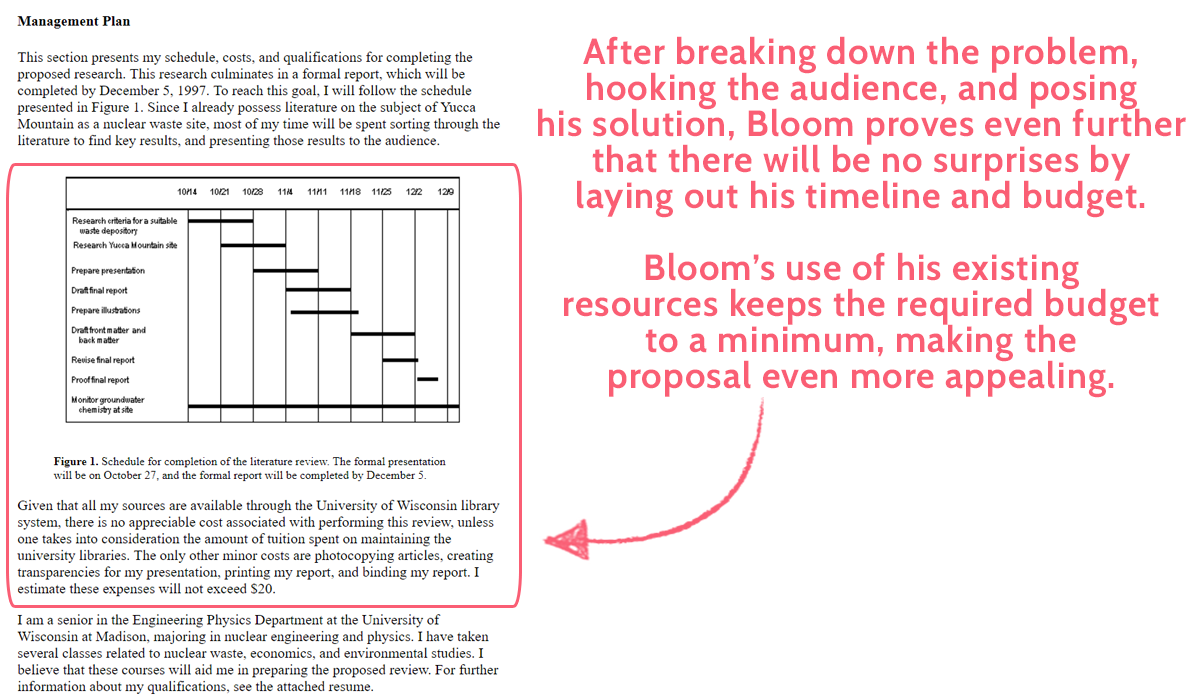
✍️⬇️ Demonstrate how project progress will be monitored (click to expand)
Without a structured way to monitor your proposal in action and to track its progress, neither you nor your audience will know whether it’s working or not, and nobody will be able to address any problems as they surface. This is a massive red flag to anyone with the power to approve your proposal because it leaves everyone in the dark until the very end of the project.
You need to show (again, using language and concepts that your audience understands) how the project will be monitored as it progresses and, therefore, how you will be able to detect problems at the earliest possible opportunity. This will also reassure your audience that they will be receiving regular updates on the project and that the tasks you’ve laid out will be carried out correctly (since they are being monitored).
In other words, this is your opportunity to limit human error in your proposal’s success by closely tracking its progress. All you have to do is show the chain of command and how everything will be tracked.
✍️⬇️ Provide a conclusion that recaps key points (click to expand)
Finally, you need to write a brief conclusion to wrap up your points, remind the audience why they should approve the proposal, and reassure them that you have thoroughly researched the topic to give them the greatest chance of success.
You shouldn’t be introducing any new information here – all you have to do is write a few sentences reminding them why the problem is important and why your proposal is the best solution for the resources it requires.
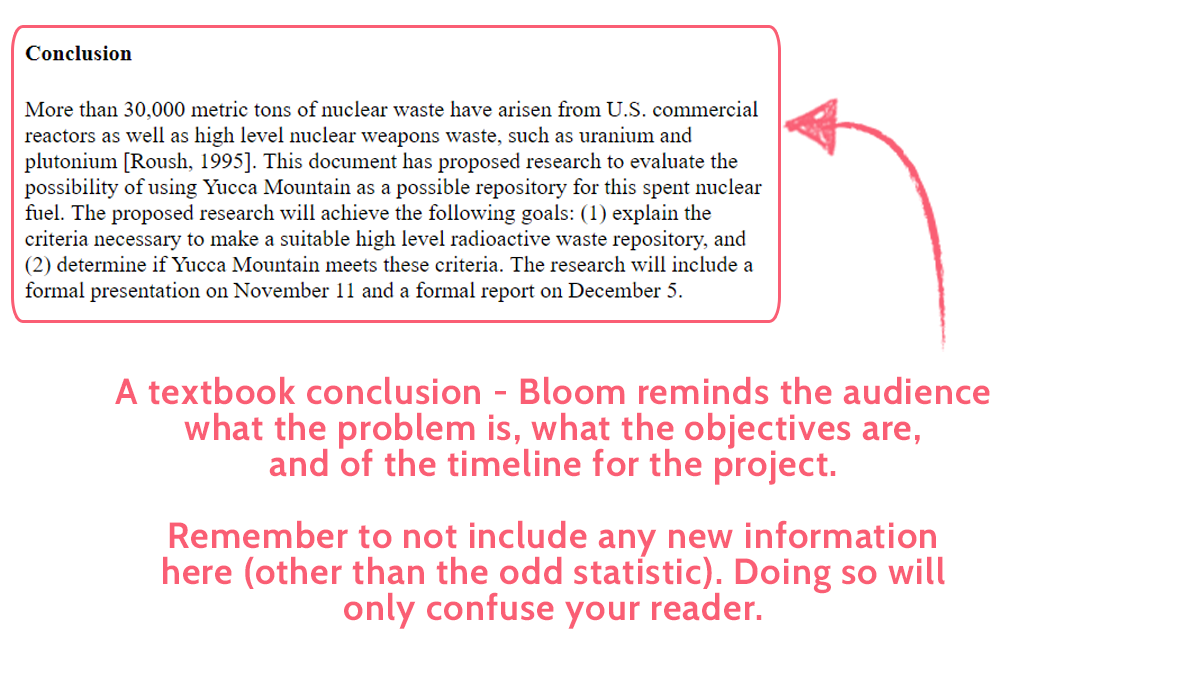
Writing a lot of project proposals? Check this out!
If you’re finding yourself writing a lot of project proposals, it might be time to consider building a process for writing them to make your life easier.
In fact, if you’re writing a lot of project proposals, you already have a process (even if you don’t know it yet). And you can always improve your processes & workflows to do smarter & better work.
That’s what we’re all about at Process Street: Helping you build powerful workflows that automate repetitive tasks and manage team knowledge so that you can focus on the work that matters (and empower your whole team to do the same).
Check out this video to find out more about who we are and what we do:
With our advanced features, you can customize your project proposal templates so it fits your organization, the type of proposal you’re writing, and your way of working like a glove:
- Stop tasks (to make sure the process is followed in the correct order & crucial project information isn’t missed)
- Dynamic due dates (to ensure proposals are finished on time)
- Task permissions (to make sure only you and whoever you grant access to can work on the proposal)
- Conditional logic (for guiding you through writing different kinds of proposals from the same template based on what you need)
- Approval tasks (so you can get the project proposal approved by management, or approve a proposal that has been drafted by someone on your team)
Not only that, but you can connect to thousands of apps through Zapier, webhooks, or API integration to automate your workflows and save time, effort, and money.
You can use Process Street to create a process for all sorts of things, not just writing project proposals. From creating client onboarding processes and to-do list templates to managing your quality management software or standard operating procedure templates.
The list is endless.
✨ More stuff to help you write amazing project proposals
To give you even more help and guidance, check out these alternative proposal templates that you can use when writing your project proposal:
- Bid Proposal Template Checklist
- Budget Proposal Template
- Construction Proposal Template Checklist
- Consulting Proposal Template Checklist
- Contractor Proposal Template Checklist
- Event Proposal Template Checklist
- Marketing Proposal Template Checklist
- Simple Proposal Format Checklist
- Sponsorship Proposal Template Checklist
- Website Proposal Template Checklist
Let us know how you organize your project proposals in the comments below!







 Workflows
Workflows Projects
Projects Data Sets
Data Sets Forms
Forms Pages
Pages Automations
Automations Analytics
Analytics Apps
Apps Integrations
Integrations
 Property management
Property management
 Human resources
Human resources
 Customer management
Customer management
 Information technology
Information technology



Ben Mulholland
Ben Mulholland is an Editor at Process Street, and winds down with a casual article or two on Mulholland Writing. Find him on Twitter here.